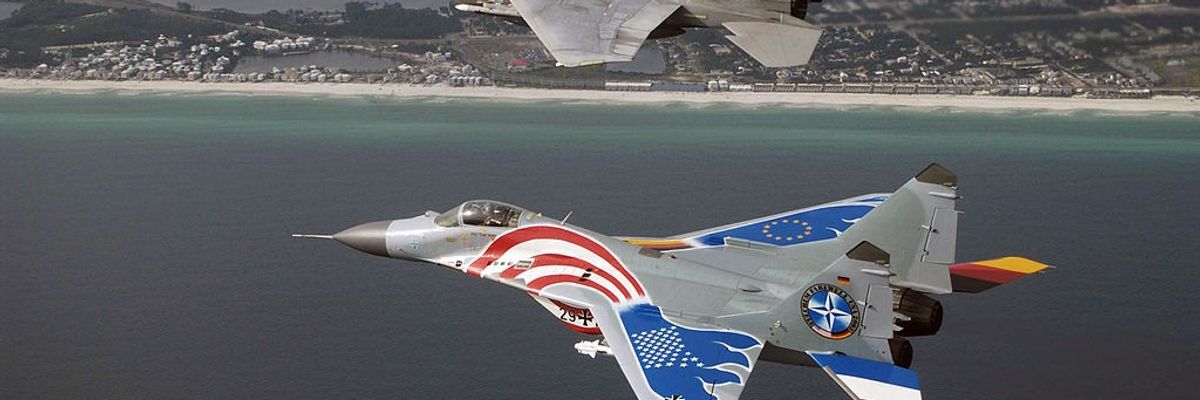The Biden administration has rebuffed a Polish proposal to transfer Poland’s 28 MiG-29 fighters to Ukraine by way of delivering them to U.S. control at Ramstein Air Base in Germany. U.S. and allied European officials were reportedly blindsided by the surprise Polish announcement, and the Pentagon shot down the proposal in public statements earlier this week.
The German government likewise wanted no part of it. The Polish government may have been acting on the “green light” that the Biden administration gave to European allies to provide Ukraine with additional military hardware, including fighter jets, but it failed to coordinate its effort with Washington and other NATO allies. Just days earlier, Poland had denied any intention of providing the jets.
The public spat between the allies over the jets reflects the difficulties in coordinating allied military assistance to Ukraine, and it also shows how the Biden administration is trying to balance its support for Ukraine’s war effort with the need to avoid direct NATO involvement in the conflict.
This is the second time since the start of the war that the possibility of transferring jets to Ukraine from eastern European allied countries has been raised publicly only to be nixed upon further consideration. The first scheme was floated by the European Union’s foreign policy and security chief Josep Borrell in late February, but the EU member states that were supposed to provide the jets said that it wasn’t happening. The Polish government doesn’t appear to have to thought through how its transfer plan was going to work, either. It fell to U.S. officials to point out the impracticality and limited value of what they were trying to do.
Providing Ukraine with high-profile, prestige military hardware may make for good headlines, but it isn't likely to have much of a positive effect on the course of the war and might very well backfire. Transferring these jets runs the risk of potential escalation of the war while offering Ukraine very limited benefits. The Pentagon concluded that the transfer would be relatively “high risk,” and Pentagon spokesman John Kirby explained, “We believe that the gain from transferring those MiG-29s is low.”
The Russian air force has been remarkably absent from the war so far, so much so that it has raised questions about whether it is even able to conduct complex operations in wartime. Whatever the reason for that strange absence, it means that the principal threat to Ukrainian civilians is not coming from the air. Ukraine still retains a large percentage of its own air force because it has not been using its own planes very much. Sending more fighter jets that aren’t needed and can’t be readily used doesn’t do much to provide real help to Ukraine’s defense. Like the much-discussed proposals for a no-fly zone, providing Ukraine with additional fighters is largely irrelevant in addressing the main military problems that Ukrainian forces face.
In addition to all this, transferring these jets would not just be a simple matter of transporting them onto Ukrainian territory and handing them over. Before any NATO jets could be delivered to Ukraine’s custody, they would have to go through a significant overhaul to remove equipment upgrades that are specific to the alliance and can’t be given to non-members. As one American defense industry official told The Wall Street Journal, “If there were a plan to do so, this would be at least a multi-month project, even operating at warp speed."
The Biden administration’s position on this issue seems sound and its reasoning is difficult to dispute, but that hasn’t stopped hardline interventionists from denouncing the decision. Rep. Adam Kinzinger, a vocal advocate of setting up a no-fly zone over Ukraine, said, “This is an utterly insane and unbelievable response from the Pentagon.” In typically hyperbolic fashion, Garry Kasparov commented, “Ukrainian civilians are being massacred and NATO is still wondering how to keep the man massacring them happy.” As he does with everything, Sen. Tom Cotton predictably accused Biden of “weakness.” The Atlantic Council’s Melinda Haring bashed the administration for supposed cowardice: “Could someone send some courage to 1600 Pennsylvania Avenue now?” Former Trump administration official Marshall Billingslea absurdly called the decision “self-deterrence.” Sen. Ben Sasse chimed in with some empty bravado, saying, “Load these MiGs up and get them to Ukrainian pilots who can still make a difference.”
For all their blustering, none of the administration’s hawkish critics was able to explain why sending these jets was so critical or what practical difference they would make. They would rather that the U.S. and NATO be seen doing something bold but useless rather than providing Ukraine with effective assistance in more prudent, inconspicuous ways.
As with other more aggressive options, sending Ukraine more jets has become a hawkish litmus test of “doing more” and it doesn’t matter to them whether that “more” is wise or useful. The hawks have the advantage that their demands for foolish action will be ignored for now, so they can continue to agitate for irresponsible and ill-conceived policies without having to worry about or own the consequences of putting them into practice. The danger is that the constant agitation for reckless policies we have been seeing over the last two weeks will gradually wear down the administration’s resistance. Writing about the possibility of escalation, Spencer Ackerman warns that “this sort of elite irresponsibility is going to intensify and look for an outlet.”
Instead of looking for new and dangerous ways to escalate the conflict, the U.S. and its allies should be working with every willing government to secure a ceasefire and to press for a diplomatic compromise that could end the war before it causes any more devastation. If the Ukrainian government is open to a compromise, that is the option that the U.S. should be encouraging them to pursue. There is always a temptation in Washington to pour an endless supply of weapons into an ongoing conflict, especially when it can be presented as a way of weakening a rival or hostile state, but it needs to be remembered that Ukraine is the country that will be damaged most severely the longer that this war continues.
Imagining that Ukraine might be turned into “another Afghanistan” is to pave the way for what could be decades of violence and deprivation for the people of Ukraine.
The untenable, escalatory proposals keep coming up in large part because the Ukrainian government keeps demanding forms of military support from the U.S. and NATO that go beyond what the alliance is prepared to give. While it is understandable that the Ukrainian government would like all the support it can get, there are some options that simply make no sense for NATO if the alliance is going to avoid direct involvement in the war. The U.S. and its allies have already gone to considerable lengths to aid Ukraine’s defense, but there are limits to how far they are going to go and that has to be understood by all concerned.
















